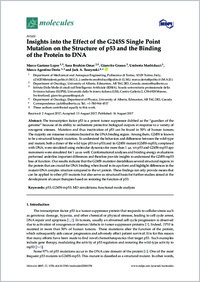Insights into the effect of the G245S single point mutation on the structure of p53 and the binding of the protein to DNA
- Lepre, Marco Gaetano Department of Mechanical and Aerospace Engineering, Politecnico di Torino, 10129 Torino, Italy
- Omar, Sara Ibrahim Department of Oncology, University of Alberta, Edmonton, AB T6G 2R3, Canada
- Grasso, Gianvito Istituto Dalle Molle di studi sull'intelligenza artificiale (IDSIA), Facoltà di scienze informatiche, Università della Svizzera italiana, Svizzera
- Morbiducci, Umberto Department of Mechanical and Aerospace Engineering, Politecnico di Torino, 10129 Torino, Italy
- Deriu, Marco Agostino Department of Mechanical and Aerospace Engineering, Politecnico di Torino, 10129 Torino, Italy - Istituto Dalle Molle di studi sull'intelligenza artificiale (IDSIA), Facoltà di scienze informatiche, Università della Svizzera italiana, Svizzera
- Tuszynski, Jack A. Department of Oncology, Department of Physics, University of Alberta, Edmonton, AB T6G 2R3, Canada
-
16.08.2017
Published in:
- Molecules. - 2017, vol. 22, no. 8, p. 1358
English
The transcription factor p53 is a potent tumor suppressor dubbed as the “guardian of the genome” because of its ability to orchestrate protective biological outputs in response to a variety of oncogenic stresses. Mutation and thus inactivation of p53 can be found in 50% of human tumors. The majority are missense mutations located in the DNA binding region. Among them, G245S is known to be a structural hotspot mutation. To understand the behaviors and differences between the wild-type and mutant, both a dimer of the wild type p53 (wt-p53) and its G245S mutant (G245S-mp53), complexed with DNA, were simulated using molecular dynamics for more than 1 μs. wt-p53 and G245S-mp53 apo monomers were simulated for 1 μs as well. Conformational analyses and binding energy evaluations performed underline important differences and therefore provide insights to understand the G245S-mp53 loss of function. Our results indicate that the G245S mutation destabilizes several structural regions in the protein that are crucial for DNA binding when found in its apo form and highlight differences in the mutant-DNA complex structure compared to the wt protein. These findings not only provide means that can be applied to other p53 mutants but also serve as structural basis for further studies aimed at the development of cancer therapies based on restoring the function of p53.
- Language
-
- English
- Classification
- Medicine
- License
- Open access status
- gold
- Identifiers
-
- RERO DOC 328286
- DOI 10.3390/molecules22081358
- ARK ark:/12658/srd1319171
- Persistent URL
- https://n2t.net/ark:/12658/srd1319171
Statistics
Document views: 200
File downloads:
- Texte intégral: 178
